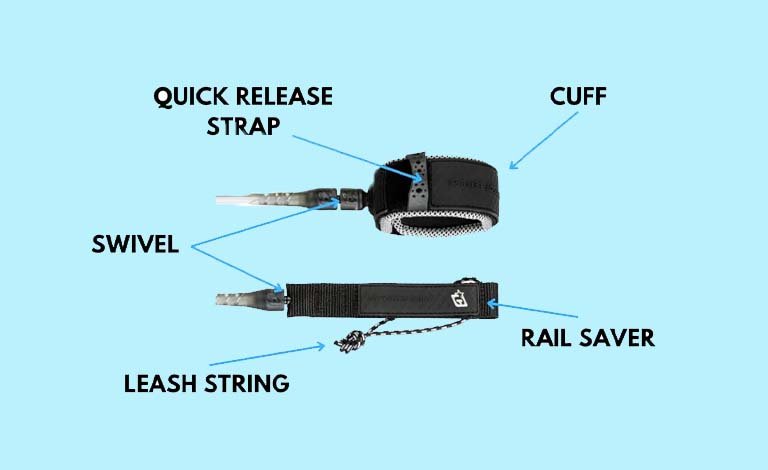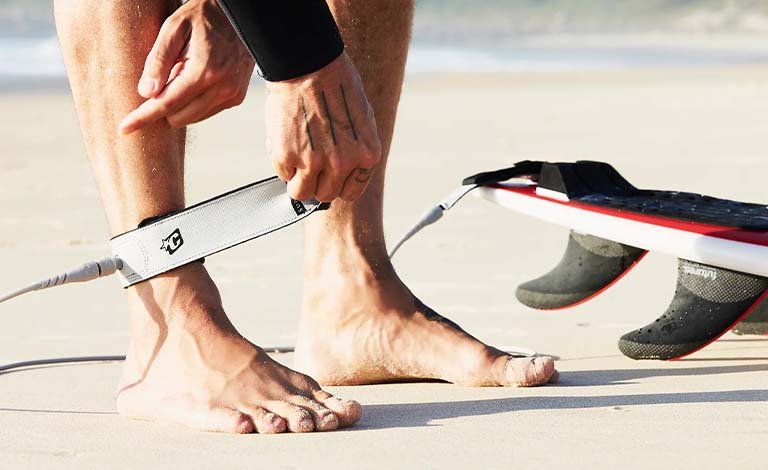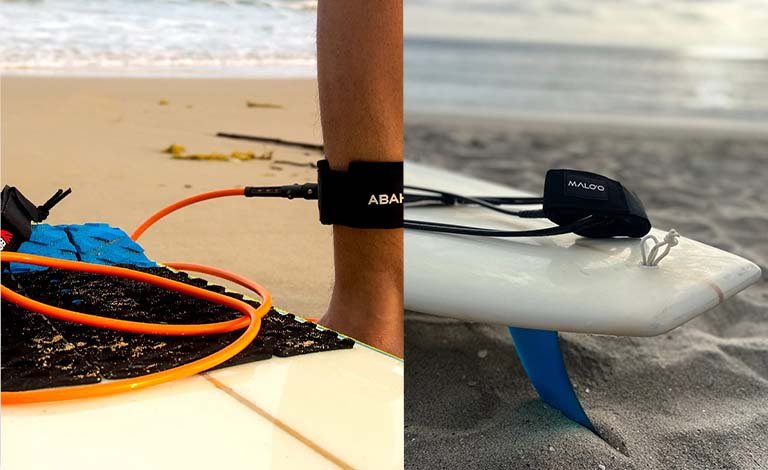As an Amazon Associate I earn from qualifying purchases.
This post contains affiliate links.
Every surfers should able to attach a Leash on surfboard is One of the essential skill. A leash is not just an accessory. it’s your lifeline in the water, ensuring your board stays close by, ready to ride the next wave. In this guide, we will explore the step-by-step process to Attach a Leash to a Surfboa. Ensuring you embark on your surfing journey equipped with confidence and knowledge.

Understanding the Importance of a Leash:
Before of attaching a leash, it’s crucial to understand why it’s such a vital piece of equipment for surfers. A leash, known as a leg rope. It is a cord attached to the tail of the surfboard and worn around the surfer’s ankle or calf. Its primary function is to prevent the board from getting away from the surfer after a wipeout. Thereby reducing the risk of injury to both the surfer and others in the water.
Step-by-Step Guide: How to Attach a Leash to a Surfboard?
Now that we understand the importance of a surfboard leash. Let’s dive into the step-by-step process of putting On a Surfboard Leash:
Choosing the Right Leash:
The first step in attaching a leash to your surfboard is selecting the right leash for your needs. Leashes come in various lengths, thicknesses, and materials. Each Leashes designed for different wave conditions and skill levels. When choosing a leash. Consider factors such as the length of your board, the size of the waves you’ll be surfing, and your own skill level. A longer leash is suitable for larger waves. While a shorter leash may be preferred for smaller, more controlled conditions.

Locating the Plug:
Once you’ve chosen the appropriate leash, the next step is to locate the plug on your surfboard where the leash will attach. The plug is a small, circular fitting typically located near the tail of the board. It’s designed to securely hold the leash’s attachment loop in place.
Position Your Board:
Lay your surfboard on a flat surface with the deck facing up and the tail pointing away from you. Position yourself near the tail of the board, where you’ll be attaching the leash.
Attaching the Leash:
With the plug identified, it’s time to attach the leash to your surfboard. Begin by inserting the leash’s attachment loop through the plug, ensuring it’s securely seated. Some leashes come with a built-in swivel mechanism to prevent tangling. Make sure this swivel is facing upward once the leash is attached.
Securing the Velcro Strap:
Most leashes feature a Velcro strap that wraps around the surfer’s ankle or calf to secure the leash in place. Slide your foot through the strap and adjust it to a comfortable fit. Making sure the Velcro is fastened tightly to prevent it from coming undone during your session. It’s essential to check the integrity of the Velcro regularly, as wear and tear can weaken its grip over time.
Adjust the Cord:
With the ankle cuff securely fastened, grab the other end of the leash (the end with the rail saver) and pull it tight. This will ensure that the leash is properly tensioned and will not drag in the water or get tangled.
Double-Check the Attachment:
Before heading into the water, double-check that the leash is securely attached to the leash plug and that the Velcro strap is fastened tightly around your ankle. Give the leash a gentle tug to test its strength and ensure that it is properly secured.
Congratulations! You’ve successfully learned how to put on a surfboard leash. Now, let’s explore some additional tips and considerations for using and maintaining your leash effectively.

Additional Tips to Use, Maintain and attach a Leash on surfboard
Inspect Your Leash Regularly:
Before each surf session, take a moment to inspect your leash for any signs of wear or damage. Pay close attention to the ankle cuff, leash cord, and rail saver, as these are the most common areas for wear and tear.
Rinse Your Leash After Each Use:
Saltwater, sand, and debris can accelerate the deterioration of your leash. After each surf session, rinse your leash thoroughly with fresh water to remove any salt or sand buildup. This will help prolong its lifespan and ensure optimal performance.
Avoid Overstretching:
While it’s essential to ensure that your leash is properly tensioned, avoid overstretching it when attaching it to the leash plug. Overstretching can weaken the leash cord and reduce its effectiveness in keeping your board attached.
Replace When Necessary:
Despite proper care and maintenance, surfboard leashes will eventually wear out and need to be replaced. If you notice any signs of fraying, stretching, or damage, it’s time to invest in a new leash to ensure your safety in the water.

Common Mistakes to Avoid:
While attaching a leash to a surfboard may seem straightforward, there are several common mistakes that surfers, especially beginners, should avoid:
Incorrect Placement:
Ensure the leash plug is located in the center of the tail and not off to one side, as this can affect the board’s stability and maneuverability.
Insufficient Securing:
Always double-check that the leash’s attachment loop is securely inserted into the plug and that the Velcro strap is fastened tightly around your ankle or calf.
Using Worn-out Equipment:
Regularly inspect your leash for signs of wear and tear, such as fraying or weakened Velcro, and replace it if necessary to maintain optimal safety.
Neglecting to Practice:
Take the time to familiarize yourself with attaching and using a leash before hitting the waves to avoid any mishaps or accidents in the water.
By following these tips and guidelines, you’ll not only learn how to put on a surfboard leash but also how to use and maintain it effectively, ensuring many memorable surf sessions to come.
Mastering the art of how to put on a surfboard leash is a fundamental skill that every surfer should possess. By understanding the purpose of a leash, following the step-by-step guide for proper attachment, and implementing additional tips for usage and maintenance, you’ll enhance both your safety and enjoyment in the water. So, the next time you head out to catch some waves, remember to secure your leash properly and ride with confidence knowing that your board will always be by your side. Happy surfing!
As an Amazon Associate I earn from qualifying purchases.
Leave a Reply